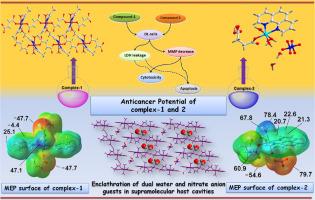含吡啶和菲罗啉的富马托和琥珀酸锰(II)和镍(II)配位固体中的超分子组装:抗癌活性和理论研究
IF 4.7
2区 化学
Q2 CHEMISTRY, PHYSICAL
引用次数: 0
摘要
合成了两个新的配位化合物[Mn(3- mepy)2(µ-fum)(H2O)2]n(1)和[Ni(phen)(such0.5)(H2O)3](NO3)0.5·2H2O (2) (3- mepy = 3-甲基吡啶,phen = 1,10-菲罗啉,fum =富马酸酯,such =琥珀酸单阴离子),并通过SCXRD技术、电子、FT-IR光谱和热重分析(TGA)对其进行了表征。聚合物化合物1具有两种不同的聚合物链,具有相同的配位环境,围绕Mn(II)金属中心的键距和键角略有不同。聚合物链通过各种氢键和π堆积相互作用相互连接,形成二维超分子层状结构。通过对2,a Ni(II)单体的晶体结构分析,揭示了Ni(II)超分子宿主腔中双客体水分子和硝酸盐阴离子的包覆作用。用密度泛函理论分析了化合物晶体结构中存在的重要的非共价相互作用。此外,MEP(分子静电势)表面计算、QTAIM(分子中原子的量子理论)和NCI(非共价相互作用)图分析也用于合理化和表征这些相互作用。计算研究证实了化合物1中氢键网络和π-堆叠相互作用在将聚合物链扩展成二维超分子结构方面具有很强的稳定作用。同样,对于化合物2,氢键自组装二聚体的QTAIM/NCI图分析显示了O - h··O和C-H··O氢键的贡献。采用台班蓝法和乳酸脱氢酶(LDH)渗漏参数,评价了化合物1和2对道尔顿淋巴瘤(DL)癌细胞的体外细胞毒性。通过双荧光染色和线粒体膜电位(MMP)研究细胞凋亡。结果表明,这两种化合物都能诱导DL细胞的细胞毒性和凋亡,这突出了它们作为治疗剂的潜力,值得进一步研究。本文章由计算机程序翻译,如有差异,请以英文原文为准。

Supramolecular assemblies in fumarato and succinato based Mn(II) and Ni(II) coordination solids involving pyridine and phenanthroline: Anticancer activities and theoretical studies
Two new coordination compounds [Mn(3-Mepy)2(µ-fum)(H2O)2]n (1) and [Ni(phen)(succH0.5)(H2O)3](NO3)0.5·2H2O (2) (3-Mepy = 3-Methylpyridine, phen = 1,10-phenanthroline, fum = fumarate, succH = monoanion of succinic acid) were synthesized and characterized by SCXRD technique, electronic, FT-IR spectroscopy and thermogravimetric analysis (TGA). Polymer compound 1 exhibits two distinct polymeric chains with identical coordination environment, slightly differing in bond distances and bond angles surrounding the Mn(II) metal centres. The polymeric chains are interconnected via various hydrogen-bonding and π-stacking interactions forming the 2D supramolecular layered architecture. Crystal structure analysis of 2, a Ni(II) monomer, reveals the enclathration of dual guest water molecules and nitrate anions in Ni(II) supramolecular host cavities. DFT (Density Functional Theory) was used to analyze the important non-covalent interactions present in the crystal structures of the compounds. Moreover, MEP (Molecular Electrostatic Potential) surface calculations, QTAIM (Quantum Theory of Atoms In Molecules), and NCI (Non-Covalent Interaction) plot analyses were also employed to rationalize and characterize these interactions. Computational studies confirm the strong stabilizing role of the network of H-bonds and π-stacking interactions in extending the polymeric chains into 2D supramolecular architectures in compound 1. Similarly, for compound 2, the QTAIM/NCI plot analysis of the H-bonded self-assembled dimer, reveals the contribution of O–H···O and C–H···O H-bonds. The in vitro cytotoxicity of compounds 1 and 2 were evaluated against Dalton’s lymphoma (DL) cancer cell line supported by Trypan blue assay and LDH (Lactate Dehydrogenase) leakage parameters. Apoptosis was investigated through dual fluorochrome staining and mitochondrial membrane potential (MMP) studies. Results demonstrated that both the compounds induced cytotoxicity and apoptosis in DL cells, highlighting their potential as therapeutic agents for further study.
求助全文
通过发布文献求助,成功后即可免费获取论文全文。
去求助
来源期刊

Journal of Molecular Structure
化学-物理化学
CiteScore
7.10
自引率
15.80%
发文量
2384
审稿时长
45 days
期刊介绍:
The Journal of Molecular Structure is dedicated to the publication of full-length articles and review papers, providing important new structural information on all types of chemical species including:
• Stable and unstable molecules in all types of environments (vapour, molecular beam, liquid, solution, liquid crystal, solid state, matrix-isolated, surface-absorbed etc.)
• Chemical intermediates
• Molecules in excited states
• Biological molecules
• Polymers.
The methods used may include any combination of spectroscopic and non-spectroscopic techniques, for example:
• Infrared spectroscopy (mid, far, near)
• Raman spectroscopy and non-linear Raman methods (CARS, etc.)
• Electronic absorption spectroscopy
• Optical rotatory dispersion and circular dichroism
• Fluorescence and phosphorescence techniques
• Electron spectroscopies (PES, XPS), EXAFS, etc.
• Microwave spectroscopy
• Electron diffraction
• NMR and ESR spectroscopies
• Mössbauer spectroscopy
• X-ray crystallography
• Charge Density Analyses
• Computational Studies (supplementing experimental methods)
We encourage publications combining theoretical and experimental approaches. The structural insights gained by the studies should be correlated with the properties, activity and/ or reactivity of the molecule under investigation and the relevance of this molecule and its implications should be discussed.
 求助内容:
求助内容: 应助结果提醒方式:
应助结果提醒方式:


